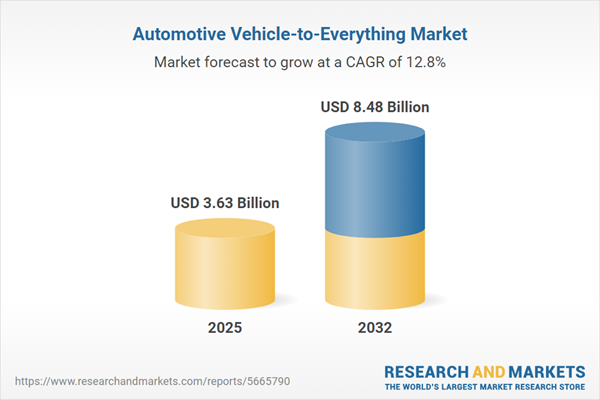Speak directly to the analyst to clarify any post sales queries you may have.
The automotive vehicle-to-everything (V2X) market is redefining global mobility, equipping organizations to match technological advances with business goals while responding quickly to regulatory and operational changes.
Market Snapshot: Automotive Vehicle-to-Everything (V2X) Market Overview
The V2X market is charting steady growth, with its current valuation at USD 3.23 billion and a projected increase to USD 3.63 billion by 2025, reflecting a CAGR of 12.79%. This advancement is shaped by ongoing technology evolution, new safety imperatives, and heightened investment in digital and hardware infrastructure. Industry participants, alongside regulatory bodies and consortia, are shaping the standards that govern compliance, risk management, and collaboration. Modernization in mobility now requires organizations to continually reassess and update their technology, compliance strategies, and operational models to keep pace with shifting competitive dynamics.
Scope & Segmentation: Defining the V2X Ecosystem
This report provides a clear landscape for executives seeking growth opportunities in automotive connectivity. Market segmentation highlights the primary factors accelerating V2X adoption and delineates emerging areas of opportunity:
- Offering Types: Sensors, cameras, communication modules, consulting services, integration support, operational safety solutions, digital platforms, and ongoing technological assistance all underpin scalable V2X deployment and long-term ecosystem resilience.
- Communication Modes: Solutions span vehicle-to-vehicle, infrastructure interaction, pedestrian communication, and cutting-edge digital frameworks, supporting secure and efficient interoperability among all mobility stakeholders.
- Application Segments: Advancements include infotainment, real-time data connectivity, sophisticated traffic management, advanced driver assistance functions, toll automation, and emergency alert systems, each contributing specific value enhancements for safety and user experience.
- Vehicle Types: Both commercial fleet and passenger vehicle solutions enable seamless modernization and serve as foundational technologies for strategies targeting autonomous mobility and next-generation operational efficiency.
- Regions: Analysis covers the Americas, Europe, Middle East & Africa, and Asia-Pacific. The report examines regulatory diversity, public and private funding mechanisms, and pace of technology integration in critical markets such as Germany, Saudi Arabia, South Africa, China, India, and Japan, offering valuable perspectives on regional adoption trends.
- Companies Analyzed: Strategic profiles include Aptiv PLC, Audi AG, Continental AG, Danlaw Inc., Denso Corporation, Ficosa Internacional SA, Ford Motor Company, General Motors Company, HARMAN International, Hyundai Motor Company, Infineon Technologies AG, Intel Corporation, Kapsch TrafficCom AG, NXP Semiconductors N.V., Qualcomm Incorporated, Robert Bosch GmbH, STMicroelectronics International N.V., and Volkswagen Group, focusing on regulatory compliance and integration of advanced technology.
Key Takeaways for Senior Decision-Makers
- Collaboration among the automotive, technology, and policy sectors is crucial for strengthening adaptability and delivering cohesive responses to evolving digital and safety standards.
- Emphasizing interoperability and cybersecurity supports deeper partnerships between manufacturers and technology providers, resulting in standardized and resilient V2X implementations.
- Migration to cloud-native architectures and the adoption of AI-driven maintenance tools accelerate digital transformation, streamline fleet management, and open pathways to new, data-centric business models.
- Innovation across industries enables incremental feature upgrades, supporting long-term goals for autonomy while adapting flexibly to immediate operational requirements.
- Changing compliance requirements and regional regulations drive ongoing adjustments in deployment approaches and encourage the development of adaptive operational strategies.
Tariff Impact: Strategic Supply Chain Adaptations
Recent U.S. trade policy adjustments impacting automotive semiconductors and communications equipment have required stakeholders to rework their supply chains. Initiatives include diversifying the supplier ecosystem, expanding nearshore production, and leveraging modular software. These adaptations help organizations uphold stability and rapidly recalibrate their technical roadmaps to stay ahead of trade variations.
Methodology & Data Sources
This research applies a blended approach, integrating executive interviews, regulatory reviews, expert industry input, and patent landscape analysis. A combination of qualitative and quantitative insights delivers actionable intelligence to inform strategic planning in the V2X ecosystem.
Why This Report Matters
- Supports teams with impartial, data-driven insights to navigate the pace of change across the V2X landscape and streamline strategic execution.
- Bolsters organizational readiness for evolving supply chain and compliance demands, maintaining a competitive position in automotive mobility.
- Facilitates well-informed partnership development and deployment planning, ensuring measurable growth in both established and fast-growing international markets.
Conclusion
Organizations equipped with robust, actionable insight from this study are well-positioned to anticipate emerging mobility shifts, enhance strategic readiness, and deliver sustained value in the evolving V2X landscape.
Additional Product Information:
- Purchase of this report includes 1 year online access with quarterly updates.
- This report can be updated on request. Please contact our Customer Experience team using the Ask a Question widget on our website.
Table of Contents
3. Executive Summary
4. Market Overview
7. Cumulative Impact of Artificial Intelligence 2025
List of Figures
Companies Mentioned
The companies profiled in this Automotive Vehicle-to-Everything market report include:- Aptiv PLC
- Audi AG
- Continental AG
- Danlaw, Inc.
- Denso Corporation
- Ficosa Internacional SA
- Ford Motor Company
- General Motors Company
- General Motors Holdings LLC
- HARMAN International
- Hitachi Solutions, Ltd.
- Hyundai Motor Company
- Infineon Technologies AG
- Intel Corporation
- Kapsch TrafficCom AG
- NXP Semiconductors N.V.
- Qualcomm Incorporated
- Robert Bosch GmbH
- STMicroelectronics International N.V.
- Volkswagen Group
Table Information
| Report Attribute | Details |
|---|---|
| No. of Pages | 188 |
| Published | November 2025 |
| Forecast Period | 2025 - 2032 |
| Estimated Market Value ( USD | $ 3.63 Billion |
| Forecasted Market Value ( USD | $ 8.48 Billion |
| Compound Annual Growth Rate | 12.7% |
| Regions Covered | Global |
| No. of Companies Mentioned | 21 |









